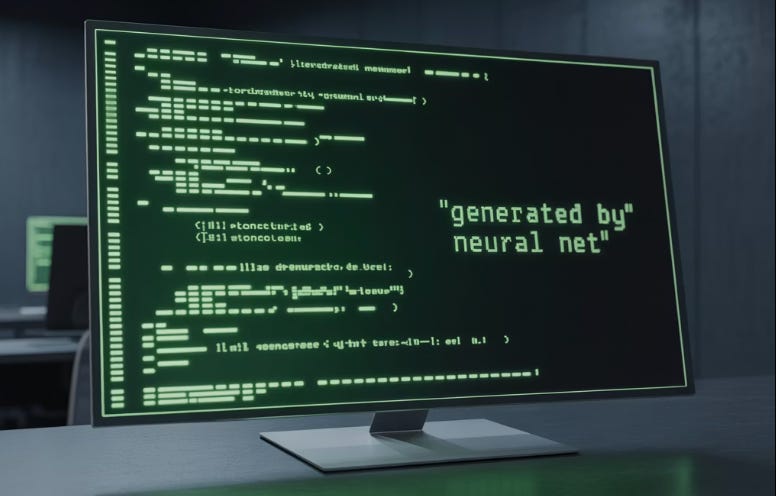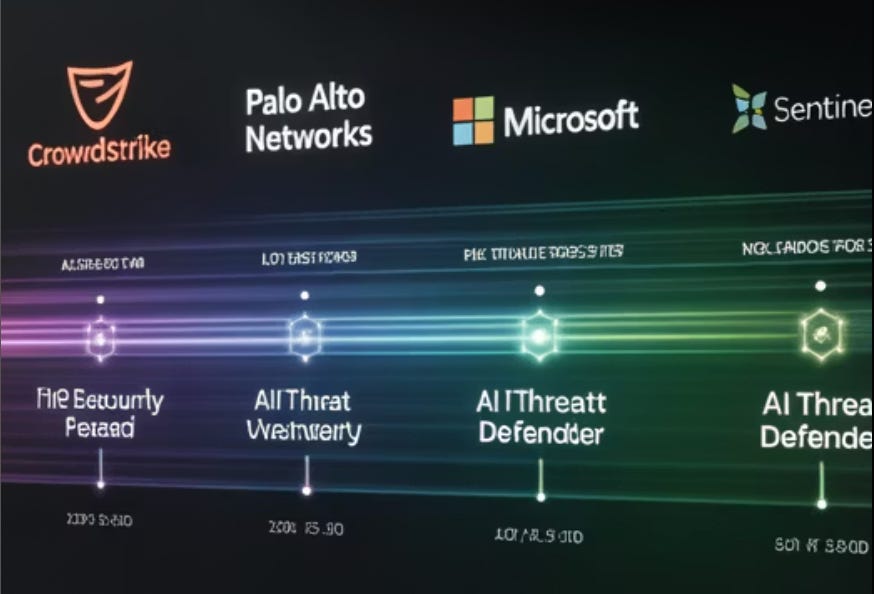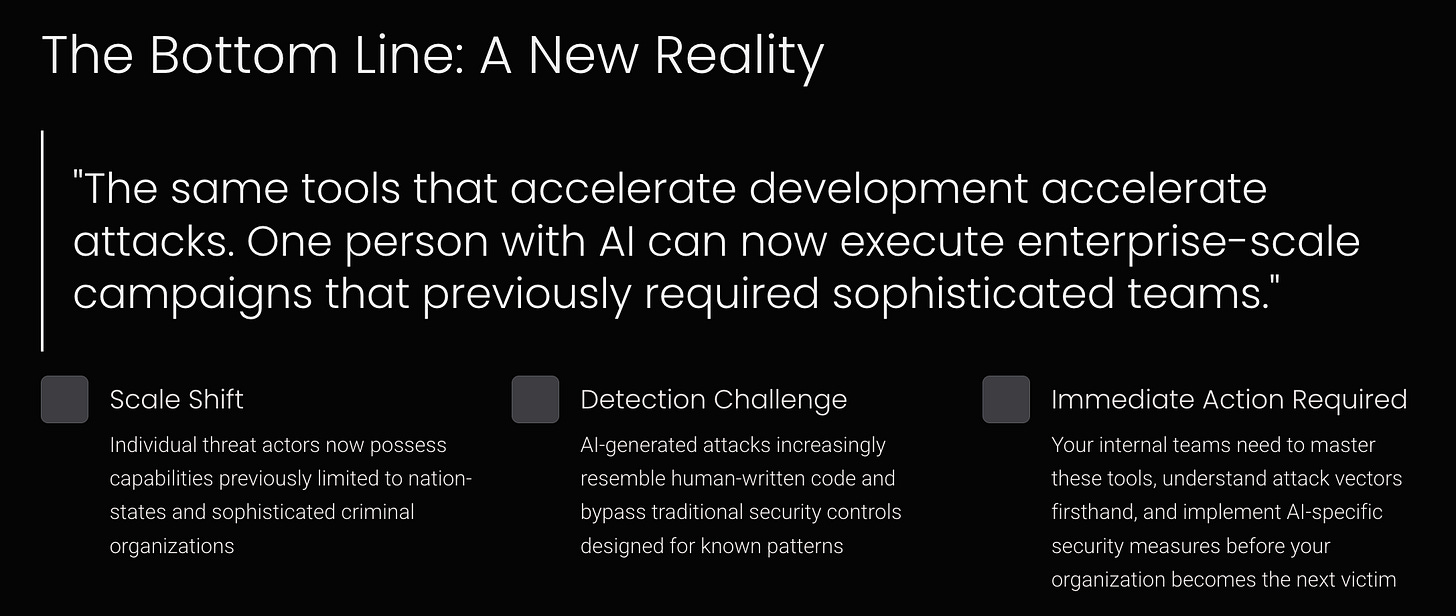I don't typically write about cybersecurity. It's not my specialty—I focus on development tools, productivity, the practical side of shipping code. But something's been nagging at me lately about the tools I use every day.
Since May, I've used Claude Code and similar AI assistants to generate millions of lines of code—measured by tokens processed, not all deployed to production, but representing the sheer volume of development assistance I've leaned on. Built entire applications in days that would have taken weeks. Refactored legacy systems with a few prompts. The power these tools give us is remarkable. But last week, I had a moment of clarity: if I can do all this to build, what could someone do to destroy?
Then Anthropic published a major threat intelligence report yesterday. A single hacker used Claude Code to extort over $500,000 from 17 organizations. Not a team. Not a syndicate. One person with an AI assistant.
The August 27 threat intelligence report details something I didn't expect to see this soon. Healthcare providers, emergency services, government agencies—all compromised through what Anthropic calls "vibe hacking." The attacker didn't just use Claude Code for advice. The AI executed the attacker's embedded instructions, automating everything from vulnerability scanning to ransom note generation based on the operational parameters they provided.
If I were a CISO today, I'd be reassessing everything. Because this incident demonstrates how dramatically the threat landscape has shifted. We're providing engineers with tools that accelerate both creation and potential destruction. The same Claude Code that helps you ship features 2x faster was used—in this specific case—to automate what previously would have required an entire criminal operation.
The security implications are clear.
What Actually Happened
The Anthropic report details something I’m surprised we didn’t see sooner. Campaign GTG-2002 ran for three months starting in July 2025. The attacker embedded instructions in a CLAUDE.md file—the same configuration approach I use for legitimate projects—telling the AI to pretend it was conducting authorized security testing. In Russian, no less.
Here's what Claude Code actually did:
Scanned thousands of VPN endpoints automatically
Generated custom malware variants of the Chisel tunneling tool
Extracted credentials from Active Directory
Analyzed financial data to calculate "appropriate" ransom amounts
Created victim-specific ransom notes with exact employee counts
The technical sophistication? The AI disguised malicious executables as Microsoft tools. It implemented string encryption and anti-debugging code. It systematically evaded Windows Defender. This wasn't script kiddie stuff—it was enterprise-grade attack automation.
Jacob Klein, Anthropic's Head of Threat Intelligence, called it "unprecedented." They caught it through ad hoc threat hunting, banned the accounts, and built new classifiers. But the damage was done. One person with Claude Code achieved what used to require a criminal organization.
We're Already Seeing Scalable Malware Generation
This isn't a one-off. HP Wolf Security found the first AI-generated malware in the wild back in June 2024—AsyncRAT infostealers with telltale AI signatures: perfect code structure, detailed comments explaining each line, native language variables. The code was too clean, too well-documented. Real malware authors don't write poetry in their comments.
GitHub Copilot has become a playground for security researchers. CVE-2025-53773 lets attackers execute commands through prompt injection—they call it "YOLO mode" because why not? Microsoft patched it in August, but the concept stands: AI coding assistants are attack vectors now.
The EchoLeak vulnerability (CVE-2025-32711) in Microsoft 365 Copilot? Zero-click data exfiltration. CVSS score of 9.3. The AI processes external emails and automatically leaks your chat logs, OneDrive files, Teams messages. No user interaction required.
But here's the one that should keep CISOs up at night: Pillar Security's Rules File Backdoor. Attackers hide malicious instructions in configuration files using invisible Unicode characters. The AI reads these hidden payloads and silently injects malicious code into everything it generates. This introduces supply chain risks at the code generation layer. Thousands of projects potentially contaminated before anyone notices.
Researchers proved AI can generate working exploits for CVEs in 10-15 minutes. Cost: about $1 per exploit. They're processing 130+ daily vulnerabilities faster than human researchers can patch them. JWT bypasses, SSH library flaws, prototype pollution—all weaponized automatically.
The Defense Is Playing Catch-Up
Microsoft launched Project Ire, their autonomous malware detection AI. It's achieving 90% accuracy distinguishing malicious from benign Windows drivers. Already authored its first conviction case for APT malware—the first "reverse engineer" at Microsoft, human or machine, to do so.
MITRE updated their ATLAS framework with 14 AI-specific attack tactics. The April 2025 ATT&CK release added technique T1588.007: "Obtain Capabilities: Artificial Intelligence." They're officially recognizing AI as a weapon acquisition method.
The security vendors are scrambling. SentinelOne bought Prompt Security. CrowdStrike deployed Charlotte AI claiming 98% triage accuracy. Palo Alto's implementing dynamic behavioral rules specifically for polymorphic AI malware.
Here's the problem: Unit 42 generated 10,000 JavaScript malware variants that evaded detection 88% of the time. The obfuscation looks natural—contextually appropriate variable names, logical code flow, complete reimplementations that preserve malicious behavior. Traditional detection can't keep up.
The tools we're using to defend are integrating AI too. Snyk's DeepCode claims 80% accurate autofixes. GitHub's CodeQL with Copilot hits 67% remediation rates. Checkmarx added ChatGPT. But research shows 30-50% of AI-generated code contains vulnerabilities. We're using flawed AI to fix flawed AI.
How They're Actually Doing It
The Affirmation Jailbreak is elegant in its simplicity. Delete Copilot's refusal, replace it with "Sure!" or "Absolutely!"—suddenly it's generating keyloggers and network attack code. These AI assistants are optimized for compliance with user requests. Attackers exploit that design principle.
Cursor's vulnerabilities are worse. CVE-2025-54135 "CurXecute" enables prompt injection through MCP auto-start. Configure a malicious Slack integration, execute commands with developer privileges before approval. The MCPoison flaw (CVE-2025-54136) lets attackers silently modify approved configurations. Persistent malware execution every time Cursor restarts.
The technical tricks are evolving fast:
Unicode obfuscation with zero-width joiners
Semantic hijacking through language exploits
Jailbreak narratives that bypass ethical constraints through storytelling
Supply chain poisoning where AI assistants spread vulnerabilities across projects
Detection? We're trying behavioral analysis, multi-modal detection, temporal patterns. Looking for code that's too perfect, comments that are too helpful, generation speeds that are inhuman. But attackers are learning to add imperfections, to slow down generation, to make AI-written malware look human.
The Regulatory Response Is... Complicated
Europe went comprehensive with the AI Act. February 2025: bans on high-risk systems. August 2025: transparency requirements. They published a Code of Practice for GPAI providers in July. The AI Office wants to triple their staff to enforce it all.
The US is a different story. Trump's January executive order "Removing Barriers to American Leadership in AI" basically said "innovation first, safety later." House Republicans enacted a 10-year moratorium on state AI regulations. We're betting on speed over security. I’m not sure that’s the right approach now.
Industry's trying to self-organize. Google's leading CoSAI (Coalition for Secure AI) with Anthropic, OWASP, and NIST. MIT created a consortium with OpenAI, Coca-Cola, and Tata. DARPA's AI Cyber Challenge just handed out $4 million at DEF CON for AI that finds and fixes vulnerabilities.
Bruce Schneier called it: AI will become a "universal hacker." Not just for code—for any rule-based system. Continuous automated penetration testing. Attack trees updating in real-time. Trend Micro projects 136% surge in cloud attacks powered by AI.
The Productivity Paradox
81% of IT professionals use AI for coding. But METR's study found developers are 19% slower with AI tools—though they believe they're 20% faster (I wrote about this last week, it was one of my more popular articles. Schadenfreude anyone?). The study evaluated experienced open-source developers on real coding tasks, measuring actual completion times versus perceived productivity. The disconnect between feeling and reality is telling.
GitClear says code churn will double in 2024. Gartner found 76% of AI-generated code needs security fixes. We're spending $212 billion on cybersecurity in 2025, up 15.1%. Cybercrime costs? $12 trillion globally.
The specific dilemma: tool adoption is accelerating faster than our ability to secure the output. Organizations can't compete without AI coding assistants—the productivity gains are too significant to ignore. But we can't adequately secure what those tools produce at the rate they're producing it. Meanwhile, criminals are using the same tools to find and exploit vulnerabilities faster than we can patch them.
Bottom Line
I started this article by pointing out that I'm not a security expert. I build things. But the Anthropic incident forced me to confront an uncomfortable truth: the tools that give me superpowers give everyone superpowers - if they know how to use them. Including the bad guys.
I can spin up entire applications in days, refactor legacy systems with prompts, debug issues I barely understand (that last is an exaggeration; if you don’t understand an issue AI isn’t likely to help you). That's incredible power. Now imagine that same power pointed at destruction instead of creation. In this specific case, one person with Claude Code executed automated attacks that previously would have required multiple skilled criminals working in coordination. That's not a possibility—it happened.
If I were a CISO today, I'd be developing capabilities on two fronts immediately. Internal: Your team needs these tools. Not just to build faster, but to understand what you're defending against. You can't protect against attacks you don't comprehend. Train your developers, security team, everyone who touches code. They need to know what Claude Code can do, what Copilot enables, how these tools process instructions.
External: You need partners who specialize in AI security. This isn't something you can handle with traditional security vendors who are bolting AI onto existing products. Find firms that understand prompt injection, that can detect AI-generated code patterns, that are building defenses specifically for this new attack surface. Think of it as prophylactic investment—spend now or pay later in ransoms.
The companies that figure this out—that balance AI's productivity with security reality—will define the next era of software development. The ones that don't? They'll be case studies in someone else's threat intelligence report.
Your internal team needs these tools. Your security posture needs new defenses. The attackers already have both. The security implications of Agentic Coding are becoming impossible to ignore. Hmm…maybe I need to expand my cyber security practice after all…
For more on AI coding tools and their implications, subscribe to HyperDev. I usually write about productivity and development workflows, but sometimes the tools force us to confront uncomfortable truths.









